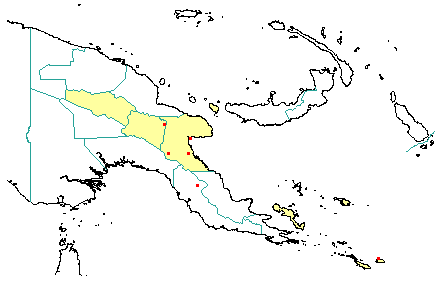
in PNGplants database
PNGTreesKey – Planchonella firma (Miq.) Dubard |
Barry Conn (NSW) & Kipiro Damas (LAE).
Guide to trees of Papua New Guinea
Copyright held by the authors, National Herbarium of New South Wales, and Papua New Guinea National Herbarium
Annales de l'institut botanico-géologique colonial de Marseille, Séries 2 Vol. 10: 59 (1912)
Family: Sapotaceae
Dicotyledon
Timber Group: Major exportable hardwood
Field Characters: Large canopy tree (up to 25 m high); Bole cylindrical (up to 50 cm diam.); straight (bole up to c. 20 m long); buttresses buttresses present; spines spines absent; aerial roots aerial roots absent; stilt roots stilt roots absent; Bark brown, rough, pustular, lenticels elongated vertically; less than 25 mm thick; bark blaze consisting of one layer; faintly to non-aromatic; outer blaze pale red, markings absent; inner blaze pale red, markings absent; bark exudate (sap) present, white/milky, flowing or not readily flowing (spotty), colour not changing on exposure to air, sticky; terminal buds not enclosed by leaves.
Indumentum: Complex hairs absent; stinging hairs absent; mature twig indumentum (hairs) absent.
Leaves: Leaves spaced along branches, spiral (leaves occurring singly at a node and arranged spirally up the branchlet), simple (a leaf composed of a single blade); petiole present, winged, attached to base of leaf blade, not swollen; leaves broadest at or near middle, (6.5-) 9.0-11.5 cm, (1.5-) 3.5-4.5 cm; symmetric, entire, not dissected or lobed, acuminate (shortly), venation pinnate, secondary veins open, prominent, intramarginal veins absent; leaves lower surface pale green or brown, upper surface dark green, indumentum (hairs) absent; absent; domatia absent; stipules absent.
Flowers: Inflorescence axillary or on the trunk or branches (mostly crowded below leaves), flowers arising from a single point, cones absent; flowers bisexual (flowers sweetly aromatic like odour of ripe bananas), stalked, flowers with many planes of symmetry, 4.5-6.0 mm long, diameter small (up to10 mm diam.) (c. 6 mm diam.); perianth present, with distinct sepals and petals whorls, inner perianth white or cream-coloured; 5, some or partly joined; stamens 5, present, free of each other, joined to the perianth; ovary superior, carpels joined (when more than one), locules (4-) 5 (-6); styles solitary, 1.
Fruits: Infrutescence single or arising from single point, fruit 15.0 mm long, dark red or brown, not spiny, fleshy, simple, indehiscent, berry; seeds 1-5, about 10 mm long, not winged, broad (as wide as long) (laterally flattened), seed 1-10 mm diam.
Distribution: Morobe, Western Highlands, Eastern Highlands & Papuan Islands.
 | Botanical records in PNGplants database |
Notes: Notes Pennington, T.D. (1991) The Genera of Sapotaceae (Royal Botanic Gardens Kew & New York Botanical Garden) reduced this species to Pouteria firma (Miq.) Baehni as part of Pouteria section Oligotheca. It is here maintained as Planchonella firma (Miq.) Dubard based on the recent molecular study by Barthish, I.V., Swenson, U., Munzinger, J. and Anderberg, A.A. (2005) American Journal of Botany 92(4): 667-673. However, it is possible that this taxon will eventually be placed in the genus Beccariella (Jessup pers. comm. 2006).